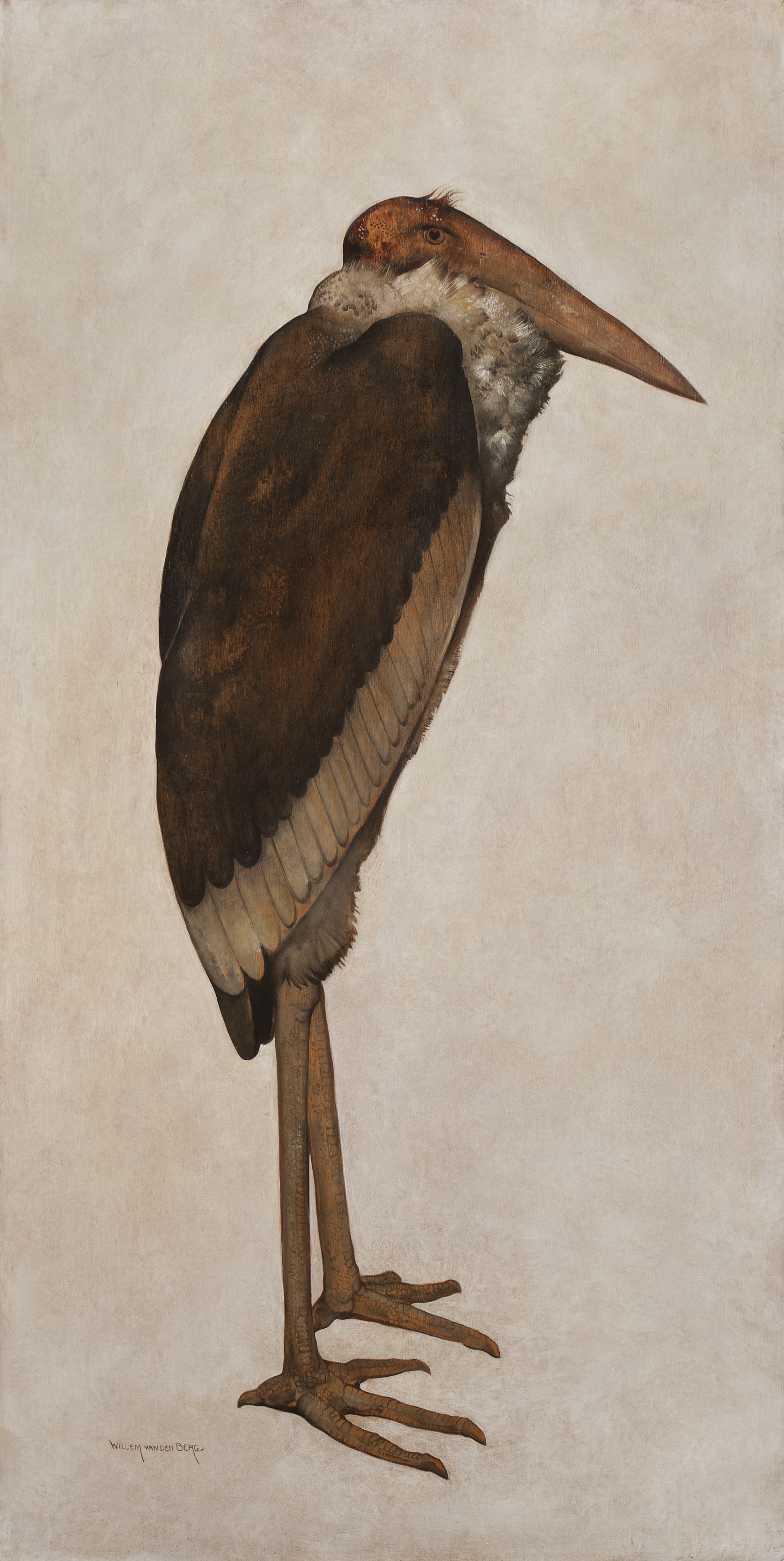WILLEM VAN DEN BERG (The Hague 1886 – Leiden 1970)
A Marabou Stork
signed WILLEM VAN DEN BERG. in the lower left, and numbered on the reverse 32
oil on board
42 x 21 1/5 inches (106.6 x 53.7 cm)
PROVENANCE
Private Collection, Utrecht, until 2015
The marabou stork lives on the Savannahs, plains, and marshes of Africa. It averages 59 inches (1.5 meters) in height with a wing span of 110 inches (2.6 meters). Its legs and toe bones are hollow, which aid in the bird’s ability to fly. Its head is devoid of feathers, the plumage black and white, with a white ruff at the base of the neck. The bill is long and quite powerful. Although usually silent, it will clack its beak if thought to be threatened. A great deal of the marabou stork’s time is spent standing still. The only physical difference between the sexes is that females are slightly smaller. They tend to mate for life, and both sexes take turns incubating their nests for a period of time usually lasting between 29-31 days. Often they gather in large groups which can reach as many as 1,000 birds.[1]
This magnificent image is indicative of Willem van den Berg’s fascination with birds, a constant factor throughout his career. Always drawn to striking subject matter, whether man or beast, the innate charm of A Marabou Stork is memorable.
Willem van den Berg painted still lifes, animals, genre, landscapes, and portraits, as well as peasants, farmers, and particularly Scheveningen and Volendam fisherfolk. He first trained with his father Andries van den Berg, a painter, print-maker, and teacher at the Academy in The Hague. He later enrolled at the Academie voor Beeldende Kunst, The Hague, and was a student of Carel Frederick Louis Wild, as well as Willem Adriaan van Konijnenburg. Van den Berg took study trips to Belgium, Italy, England, and worked with the Barbizon artists in France. Afterwards he became an instructor in the Eerste Nederlandse Vrije Studio, The Hague. In 1926 he exhibited a painting at the Jeu de Paume, Paris. In 1938 he moved to Amsterdam. From 1939 until 1953, he was the Director as well as an instructor at the National Academy of Fine Arts, Amsterdam. He proved to be a popular teacher, and his students included Jan Batermann, Joop Broek, Jacobus Johannes Brouwers, Jan Engelberts, Lydia Hoeffelman, Bob Hoope, and Kurt Löf, among many others. In 1959 he received second prize at the International Art Exhibition, Edinburgh. He was a member of Arti et Amicitiae, Amsterdam; the Pulchri Studio, The Hague; and one of the Gooische artists who painted in Laren. He also worked as a graphic artist executing linocuts and lithographs. His works can be found in the museums of Amsterdam, Assen, Budapest, Deurne, Enkhuizen, The Hague, Laren, Rotterdam, Trieste and Utrecht.[2]
The chief influences on his work were the paintings of Willem Adriaan van Konijnenburg, Johann Joseph Aarts, and the old masters, especially Pieter Brueghel the Elder.[3] As a result of his time among the Barbizon painters, a connection to Jean François Millet is also evident.[4] Van den Berg has been characterized as a naïve artist, and was included in such shows as Meesters der Europese Naieven at the Centraal Museum, Utrecht in 1970. Such terminology seems somewhat inadequate when describing the particular magic Van den Berg created, as he always remained unaffected by contemporary trends, continually seeking his own way, perpetually defying definition.[5]
[1] “Marabou Stork” on www.vulture-territory.com; “Leptoptilos crumeniferus marabou” on Animal Diversity Web/animaldiversity.org/accounts; and “The Marabou Stork (Leptoptilos crumeniferus) on South Africa Explored, www.SA-Venues.com.
[2] Biographical information taken from Hans Vollmer, Allgemeines Lexikon der Bildenden Künstler des XX. Jahrhunderts, volume A-D, Veb. E. A. Seemann Verlag, Leipzig, 1953, p. 177; Joachim Busse, Internationales Handbuch Aller Maler und Bildhauer des 19. Jahrhunderts, Verlag Busse Kunst Dokumentation GMBH, Weisbaden, 1977, p. 94; K.G. Saur, Allgemeines Künstlerlexikon Bio-Bibliographischen Index A-Z, München, 1999-2000, p. 318; and Dirck Brinkkemper, Peter Kersloot, & Kees Sier, “Willem Hendrik van den Berg” in Volendam Schildersdorp 1880 – 1940, Waanders Uitgevers, Zwolle, 2006, p. 56.
[3] K.G. Saur, op. cit., p. 318.
[4] Ellwood Hendrick “Netherlanders at the Arts,” in The Art World, A Monthly For the Public Devoted to the Higher Ideals, volume 3, The Kalon Publishing Company, Inc., New York, 1917, p. 234.
[5] Dirk Brinkkemper, op. cit., p. 56.
